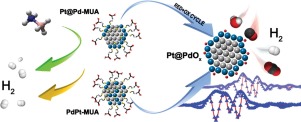Applied Catalysis B: Environment and Energy ( IF 22.1 ) Pub Date : 2018-05-08 , DOI: 10.1016/j.apcatb.2018.05.019 Matteo Monai , Tiziano Montini , Emiliano Fonda , Matteo Crosera , Juan José Delgado , Gianpiero Adami , Paolo Fornasiero

|
A widespread approach to modulate the performances of heterogeneous catalysts is the use of bimetallic nanoparticles (NPs) as the active phase. However, studying the relationship between the NPs structure and catalytic properties requires well-defined systems, having uniform composition, size and nanostructure, which cannot be achieved by traditional methods (e.g. impregnation). Here, we developed wet-chemistry synthetic routes to prepare PdPt NPs or [email protected]Pd-shell NPs of small size and well-controlled composition and structure, protected by mercaptoundecanoic acid (MUA) moieties. The pristine NPs were tested for H2 production by NH3BH3 hydrolysis, in order to systematically investigate the effect of composition and of synthetic route on the activity of the systems. Depending on the preparation method, two distinct trends of activity were observed, rationalized in terms of the extent of surface functionalization by MUA. The MUA protective layer was found to effectively stabilize the NPs dispersion while maintaining high activity in certain cases (Pt-rich NPs), and was demonstrated to be essential for catalyst recycling. In order to further study structure-activity relationships of Pd
Pt NPs after ligand removal, nanostructured Pd
[email protected]2-based catalysts were prepared by self-assembly route. Regardless of the starting NPs structure (alloy or core-shell), similar water gas shift reaction performances were observed, due to the structural rearrangements occurring upon oxidation and reduction thermal treatments, which led to the formation of Pt-rich [email protected]
Pt-shell under reducing conditions.
中文翻译:

纳米结构的Pd
调节非均相催化剂性能的广泛方法是使用双金属纳米颗粒(NPs)作为活性相。但是,研究NPs结构与催化性能之间的关系需要定义明确的系统,该系统具有均匀的组成,尺寸和纳米结构,而这是传统方法(例如浸渍)无法实现的。在这里,我们开发了湿化学合成路线,以制备受巯基十一烷酸(MUA)部分保护的小尺寸Pd Pt NP或[电子邮件保护的] Pd-壳NPs,其组成和结构得到良好控制。测试了原始NP的NH 3 BH 3产生H 2的能力水解,以便系统地研究组成和合成途径对系统活性的影响。根据制备方法,观察到两种明显的活性趋势,根据MUA的表面功能化程度合理化。发现MUA保护层可有效稳定NPs分散,同时在某些情况下(富含Pt的NPs)保持高活性,并被证明对催化剂回收至关重要。为了进一步研究
去除配体后Pd Pt NPs的构效关系,纳米结构的Pd
[电子邮件保护] 2自组装路线制备了碱式催化剂。不管起始的NPs结构是什么(合金或核壳),由于在氧化和还原热处理时发生结构重排,都观察到了类似的水煤气变换反应性能,这导致了富Pt [受电子邮件保护]
Pt的形成。-壳在还原条件下。



























 京公网安备 11010802027423号
京公网安备 11010802027423号